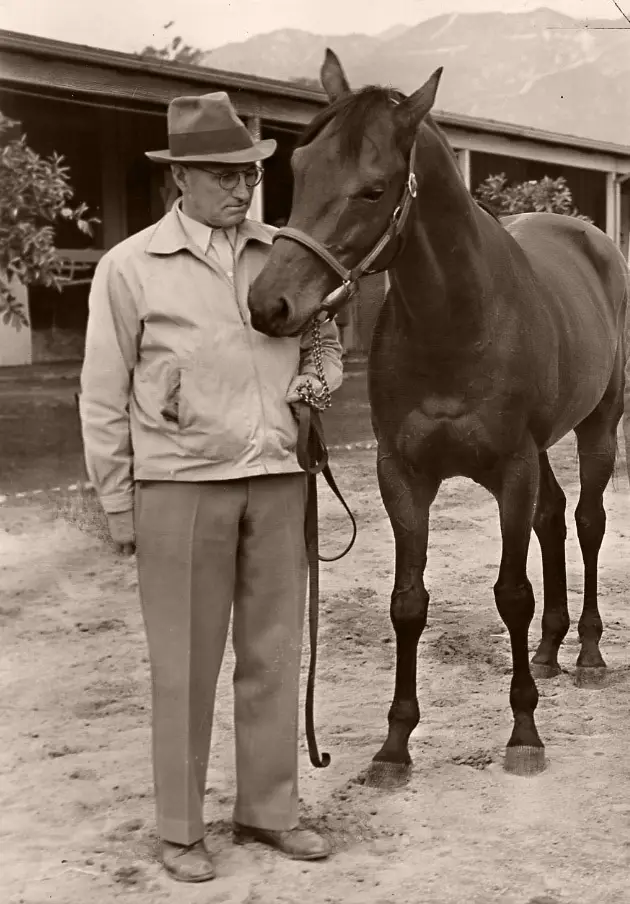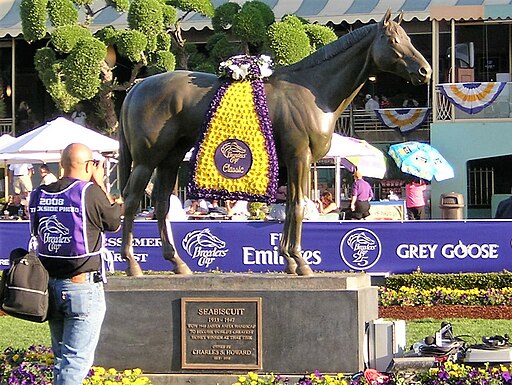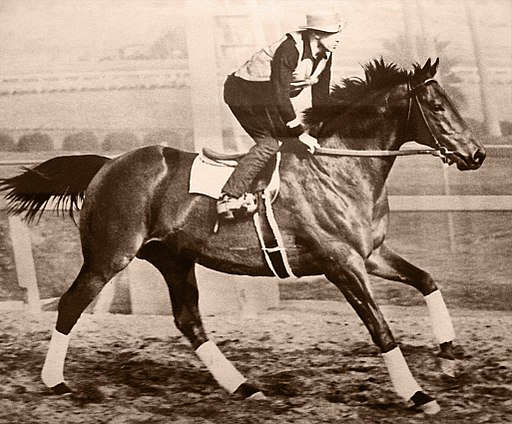Last updated: January 21, 2024
Did you know that a small, unassuming horse, once considered too insignificant to win a claiming race, transformed into one of the most celebrated legends in horse racing history? This is the story of Seabiscuit, a thoroughbred whose journey from obscurity to fame encapsulates more than just racing triumphs; it symbolizes resilience, hope, and the enduring spirit of an underdog.
Seabiscuit wasn’t just a racehorse; he was a beacon of hope during the trying times of the Great Depression. His unexpected rise to stardom and his thrilling performances on the racetrack captured the hearts of millions, transcending the sport of horse racing. His legacy is not merely about the races won or records set, but about challenging perceptions and overcoming odds, a narrative that continues to inspire.
As a lifelong equestrian and racehorse owner, my journey through the world of horse racing has not only been about understanding the sport but also about uncovering the stories that make it so compelling. Join me as we delve into the remarkable saga of Seabiscuit, exploring the depths of his character, his remarkable achievements, and the indelible mark he left on horse racing and American culture.
The Early Years of Seabiscuit
Let’s begin by exploring Seabiscuit’s roots, delve into his unassuming early years, and examine his unremarkable physical traits that belied his future greatness. These characteristics lay the foundation for an extraordinary racing legend.
Birth and Lineage: The Legacy of Man o’ War
Seabiscuit’s story begins in 1933 at Claiborne Farm, Kentucky. Born to a lineage of champions, he was a grandson of the legendary Man o’ War, one of the greatest racehorses of all time. This connection to racing royalty set high expectations from the outset. Yet, Seabiscuit’s early years would soon reveal a path quite different from his illustrious forebear.
Physical Attributes: An Unlikely Champion
In stark contrast to the imposing stature of Man o’ War, Seabiscuit was unexpectedly small and unimpressive in appearance. Standing at just over 15 hands, he lacked the typical sleek and muscular build of a racehorse. His knees were knobby, and his gait was awkward. These physical attributes led many to underestimate him, overlooking the potential hidden beneath his unconventional exterior.
Early Training and Challenges: Overcoming Doubt
Seabiscuit’s initial foray into racing was underwhelming. His early training sessions were lackluster; he seemed disinterested and lazy, showing little of the fiery spirit expected in a young thoroughbred.
In his debut racing season as a two-year-old, Seabiscuit’s performances were mediocre, failing to make a significant impact on the track. This period was marked by frequent races but few victories, casting doubts on his potential to succeed at the highest levels of horse racing.
Despite these early setbacks, Seabiscuit’s story was just beginning to unfold. Beneath his unremarkable exterior and indifferent attitude lay a resilient spirit and a capacity for greatness that would soon emerge, challenging the perceptions of all who had doubted him.

Seabiscuit winning his final race, the Santa Anita Handicap, in 1940.
Rise to Fame: Seabiscuit’s Path to Glory
Seabiscuit’s ascent to fame began with a pivotal change in ownership. In 1936, Charles Howard, a prominent businessman, saw potential in the overlooked thoroughbred and purchased him.
Under the guidance of trainer Tom Smith, known for his unconventional methods and keen eye for talent, Seabiscuit began to transform. Smith’s unique approach and Howard’s belief in Seabiscuit’s abilities marked the beginning of a remarkable turnaround.
Key Races and Victories: Triumphs on the Track
The true extent of Seabiscuit’s prowess started to unfold on the racetracks. His victories were not just wins; they were statements. Each race, from the San Juan Capistrano Handicap to the Bay Bridge Handicap, showcased his growing confidence and skill.
Seabiscuit was rewriting his story, race by race, victory by victory, culminating in becoming the top money-winner of 1937, a testament to his extraordinary abilities.
YouTube video of the Seabiscuit and War Admiral match race from 1938.
The Match Race with War Admiral: A Battle of Titans
The pinnacle of Seabiscuit’s career was the highly anticipated 1938 match race against War Admiral, the Triple Crown winner and a horse of distinguished pedigree. This race at Pimlico Race Course wasn’t just a competition; it was a cultural event, symbolizing the clash of underdog spirit against established greatness.
Seabiscuit’s victory in this epic battle was more than a win; it was an affirmation of his indomitable spirit and a moment that etched his name in the annals of horse racing history.
Seabiscuit’s Unique Characteristics: The Essence of a Legend
Seabiscuit was not just a champion racehorse; he was truly extraordinary. His distinct traits and quirks set him apart, elevating him to the status of a beloved and enduring legend.
Personality Traits: The Heart of a Champion
Seabiscuit’s personality was as distinctive as his racing style. Known for his laid-back demeanor, he often appeared sleepy and uninterested, a stark contrast to the fiery temperament typical of racehorses.
This calm nature extended to his relationships with trainer Tom Smith and jockey Red Pollard, with whom he formed deep, trusting bonds. These relationships were pivotal in unlocking Seabiscuit’s true potential, showcasing the importance of understanding and connection in nurturing talent.
Training Methods: Tom Smith’s Revolutionary Approach
Tom Smith, Seabiscuit’s trainer, played a crucial role in his development. Smith’s training methods were innovative and tailored to Seabiscuit’s unique needs. He focused on building trust and understanding the horse’s individual quirks rather than forcing him into a conventional training mold.
This approach not only refined Seabiscuit’s physical abilities but also nurtured his mental and emotional strength, crucial elements for his success on the track.
Companion Animals: A Supportive Entourage
An unusual yet significant aspect of Seabiscuit’s life was his relationship with companion animals. Pumpkin, a gentle pony, was his constant companion, providing comfort and stability. This bond was so vital that Pumpkin traveled with Seabiscuit to all his races.
Alongside Pumpkin, a stray dog and a spider monkey named Jo-Jo were part of Seabiscuit’s entourage, creating a unique and supportive environment that contributed to his well-being and success. These relationships underscored the profound impact of companionship and emotional support in the life of a racehorse.

Impact and Legacy: Seabiscuit’s Enduring Mark
Seabiscuit, a horse who transcended the boundaries of the racetrack to become a cultural icon.
Cultural Impact: A Symbol of Hope in the Great Depression
Seabiscuit’s rise to fame coincided with the Great Depression, a time when hope was scarce. His success story became a source of inspiration for many Americans struggling through economic hardship. Seabiscuit was more than a champion racehorse; he was a symbol of perseverance and resilience.
His victories on the racetrack brought joy and a sense of pride to a nation in need of uplifting moments, making him a true cultural icon of his time.
Comparison with Other Legendary Racehorses
In the annals of horse racing, Seabiscuit is often mentioned alongside other legends like Man o’ War and Secretariat. While he may not have had the same initial physical prowess or pedigree as these giants, Seabiscuit’s achievements on the track were no less remarkable.
His ability to overcome obstacles and defy expectations set him apart, making his story one of the most compelling in horse racing history.
Seabiscuit’s Legacy: Beyond the Racetrack
Seabiscuit’s influence extends far beyond his racing records. He left an indelible mark on horse racing and popular culture, symbolizing the triumph of the underdog. His story has been retold in books, films, and documentaries, continuing to inspire new generations.
Seabiscuit’s legacy is a testament to the idea that greatness can come from the most unexpected places, and his spirit continues to resonate in the world of sports and beyond.

Statute of Seabiscuit at Santa Anita Park. Source: Jlvsclrk, CC BY-SA 4.0
Beyond the Racetrack: Seabiscuit’s Life After Racing
After his illustrious racing career, Seabiscuit retired to Charles Howard’s Ridgewood Ranch in California. Here, he embraced a quieter life, far removed from the fanfare of the racetrack. Seabiscuit’s days were spent roaming the expansive pastures and occasionally being ridden for leisure.
He also played an unexpected role in ranch activities, such as helping to check cattle, showcasing his adaptability and gentle nature even in retirement.
Breeding and Progeny: Extending the Legacy
In retirement, Seabiscuit also contributed to the Thoroughbred lineage through his role as a sire. He sired over 100 foals, passing on his genes to future generations of racehorses. While none achieved the same level of fame as their sire, they carried forward his legacy in the racing world. Seabiscuit’s contribution to Thoroughbred breeding underscored his lasting impact on the sport.
Death and Commemoration: Remembering a Legend
Seabiscuit passed away in 1947, leaving behind a legacy that transcended horse racing. He was commemorated with a life-sized statue at Ridgewood Ranch, serving as a lasting tribute to his remarkable life.
His story continues to be celebrated in various forms, from books to films, ensuring that the legend of Seabiscuit will endure for generations to come. His grave at Ridgewood Ranch remains a site of homage for fans, a testament to the enduring affection and admiration for this extraordinary horse.
Seabiscuit in Media and Literature: Capturing a Legend
Books: Laura Hillenbrand’s “Seabiscuit: An American Legend” Laura Hillenbrand’s “Seabiscuit: An American Legend” is a testament to the enduring allure of Seabiscuit’s story. Published in 2001, this best-selling book offers a detailed and captivating narrative of Seabiscuit’s life, from his humble beginnings to his rise as a national icon.
Hillenbrand’s meticulous research and engaging storytelling bring to life the personalities, events, and emotions that surrounded Seabiscuit, providing readers with a comprehensive understanding of his impact both on and off the racetrack.
Film Adaptation: Bringing the Story to the Big Screen The 2003 film adaptation of “Seabiscuit: An American Legend” brought Seabiscuit’s story to a wider audience, further cementing his status as a cultural icon. Directed by Gary Ross and featuring a star-studded cast, the movie received critical acclaim and several Academy Award nominations.
Its impact extended beyond entertainment, reigniting interest in horse racing and introducing a new generation to Seabiscuit’s inspiring tale. The film’s success highlighted the timeless nature of Seabiscuit’s story and its relevance in contemporary society.

Seabiscuit and his jockey Red Pollard
FAQs About Seabiscuit and His Legacy
Did Seabiscuit win the Triple Crown?
No, Seabiscuit did not win the Triple Crown. While he achieved remarkable success in his racing career, including the historic victory against War Admiral and numerous other prestigious races, Seabiscuit never competed in the Triple Crown races, which consist of the Kentucky Derby, Preakness Stakes, and Belmont Stakes.
Did Seabiscuit win the Kentucky Derby?
No, Seabiscuit did not win the Kentucky Derby. Despite his legendary status and numerous victories in other major races, Seabiscuit never participated in the Kentucky Derby during his racing career.
What made Seabiscuit so special?
Seabiscuit was known for his unlikely success despite his small size and initial underperformance, symbolizing resilience and the triumph of the underdog.
How did Seabiscuit get his name?
Seabiscuit was named after his sire, Hard Tack, which is a type of dense, hard biscuit historically consumed by sailors. The name “Seabiscuit” playfully reflects this nautical connection and also alludes to his dam, Swing On, evoking a sense of movement and resilience.
Did Seabiscuit run in a claiming race?
Seabiscuit ran in three cheap claiming races in his two-year-old season, and no one claimed the future Hall of Famer. Incredibly, anyone could have bought him for only $2,500. In one of the claiming races, Seabiscuit not only won the race but set a new track record.
Conclusion: The Timeless Legacy of Seabiscuit
As we reflect on the remarkable journey of Seabiscuit, it becomes clear that his legacy is about much more than a series of spectacular wins on the racetrack. Seabiscuit’s story is one of resilience, hope, and the triumph of the underdog – themes that resonate deeply in the human spirit.
His rise from obscurity to greatness not only captivated the hearts of millions during his time but continues to inspire and captivate people around the world. Seabiscuit redefined what it means to be a champion.
He wasn’t the biggest, the strongest, or the most likely to succeed, yet his determination and heart led him to unprecedented success. His story reminds us that greatness can come from the most unexpected places and that perseverance and spirit often triumph over perceived limitations.
Beyond the racetrack, Seabiscuit symbolizes the enduring American spirit, particularly poignant during the challenging times of the Great Depression. His victories offered a beacon of hope and a source of joy to a nation in need, proving that heroes can emerge in the most challenging of times.
Seabiscuit’s legacy lives on, not just in the world of horse racing but in the broader cultural landscape. His story immortalized in books and film, continues to inspire and teach new generations about courage, resilience, and the power of believing in the underdog. Seabiscuit was more than just a racehorse; he was, and remains, a symbol of enduring hope and the relentless pursuit of greatness against all odds.
Call to Action
Discover more about the legends of horse racing and their inspiring stories. Visit our Horse Racing Sense website for in-depth articles, exclusive insights, and the latest updates in the world of equine sports. Join our community today and immerse yourself in the rich history and thrilling present of horse racing!
Connect with Me
- Email: [email protected]
- Social Media: Follow me on Facebook for updates, tips, and insights into the world of horses.
- Website: Visit my website horseracingsense.com, for more articles, resources, and information about horses.
- YouTube
References and Further Reading:
To continue your exploration of Seabiscuit’s story and the world of horse racing, the following sources and materials are highly recommended:
- Books:
- “Seabiscuit: An American Legend” by Laura Hillenbrand
- “The Big Horse” by Joe McGinniss
- “American Pharoah: The Untold Story of the Triple Crown Winner’s Legendary Rise” by Joe Drape
- Documentaries and Films:
- “Seabiscuit” (2003), directed by Gary Ross
- “Secretariat” (2010), directed by Randall Wallace
- “Ruffian” (2007), directed by Yves Simoneau
- Online Resources:
- The National Museum of Racing and Hall of Fame website: www.racingmuseum.org
- The Jockey Club’s official site: www.jockeyclub.com
- Biographies:
- “The People’s Horse” Cl Cole and Shannon Lc Cate
- “Man o’ War: A Legend Like Lightning” by Dorothy Ours
- “Affirmed: The Last Triple Crown Winner” by Lou Sahadi
These resources offer a comprehensive look into not only Seabiscuit’s incredible story but also the broader context of horse racing, its history, and its heroes. Whether you’re seeking detailed historical accounts, personal narratives, or cinematic portrayals, these recommendations will enrich your understanding and appreciation of this thrilling sport.



